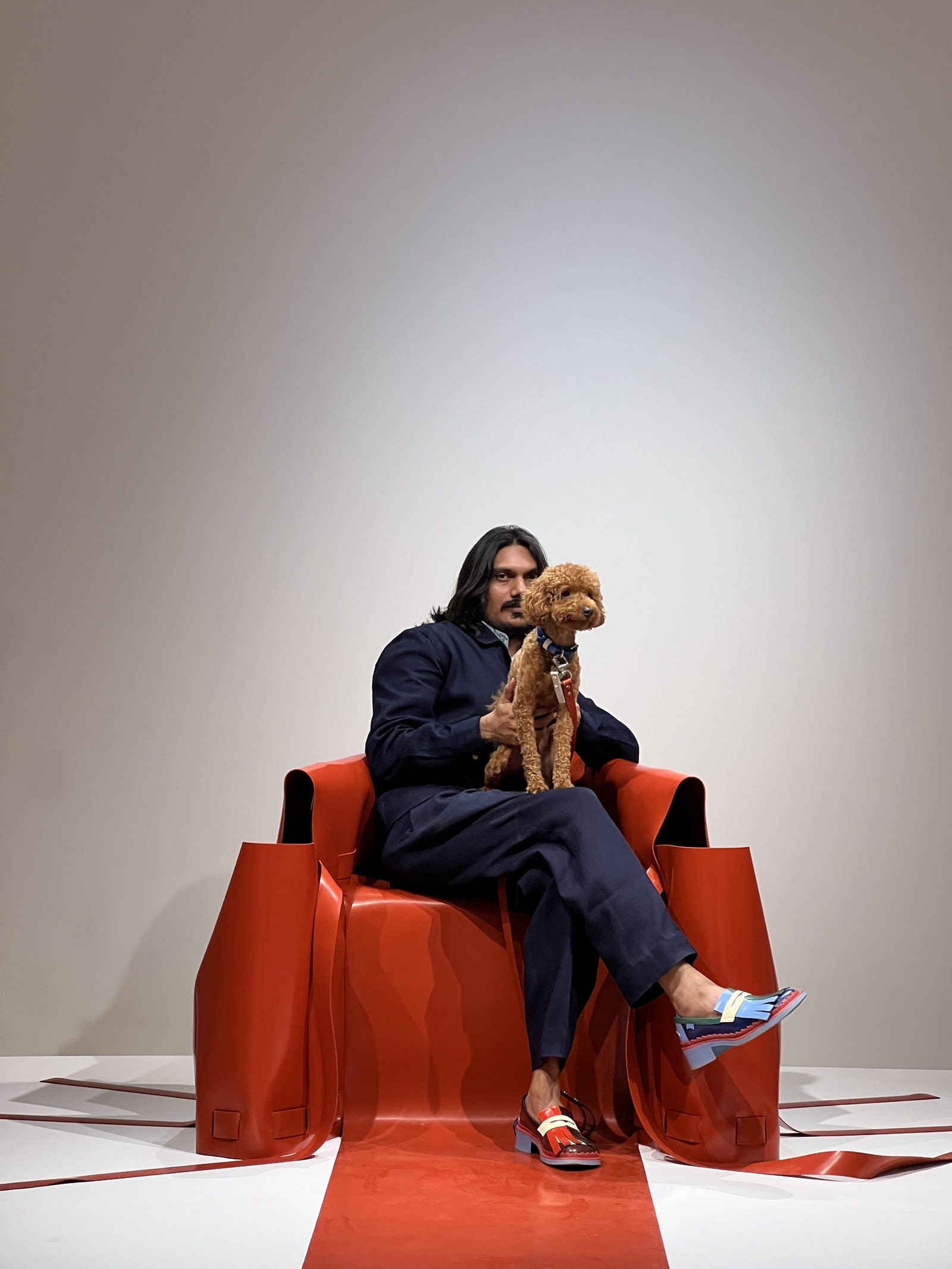When Rihanna casually perched on a bold red chair at Design Miami, it wasn’t just another moment of celebrity chic. This time, the true star wasn’t Rihanna—yeah, surprising, we know—it was actually the chair. Known as the Flap Chair, this avant-garde piece comes from Chamar Studio, a Mumbai-based design brand that’s less about trends and more about revolution.
Created by artist Sudheer Rajbhar, the Flap Chair isn’t merely furniture. It’s rebellion moulded in rubber, carrying the weight of a history that speaks of resilience, creativity, and an unflinching challenge to societal norms.
More sculpture than seat, the Flap Chair is Rajbhar’s debut in furniture, though it’s no ordinary decor. Dramatic stitching, oversized belts, and pockets turn it into a manifesto of bold creativity. Its sharp edges and commanding presence defy convention, making it a throne for those who refuse to bow – fit for Miss Fenty.
Months of meticulous labour and a team of just three artisans brought this masterpiece to life. Each chair—costing a staggering Rs 10 lakh—was crafted over 5-7 months, layer by layer, in a small Mumbai studio. Rajbhar calls it a “work of art,” not just a piece of furniture.
This theatricality isn’t accidental. Rajbhar draws on his love of fashion, blending it with the storytelling of art. The Flap Chair demands attention, not because it’s functional, but because it carries meaning.
A material that speaks of survival
The story of the Flap Chair begins far from the polished galleries of Miami or Colaba. It starts in Dharavi, one of Asia’s largest slums, where leather artisans from Dalit communities once thrived, crafting everything from bags to belts. But in 2015, a nationwide beef ban disrupted their world. Their craft, tied to a material now rendered untouchable, faced extinction.

 The brand doesn’t just create bags or chairs; it’s an endeavour to turn invisibility into visibility (Photo provided by Sudheer Rajbhar)
The brand doesn’t just create bags or chairs; it’s an endeavour to turn invisibility into visibility (Photo provided by Sudheer Rajbhar)
Sudheer Rajbhar saw an opportunity in this crisis. He turned to rubber, an unassuming yet versatile material that he would go on to master. Rubber, free from religious or political controversy, became a medium for survival and reinvention.
Rajbhar’s process transformed it into something extraordinary: layers of compressed mesh sandwiched between pigmented rubber sheets, resulting in a material as resilient as the people it represents.
Story continues below this ad
Chamar Studio: A brand with a cause
The name Chamar Studio is itself a reclamation. In India, “chamar” is a caste-based slur, a word meant to wound. Rajbhar, who grew up hearing it hurled as an insult, decided to reclaim it. “If Paris can have Hermès, why can’t India have Chamar?” he asks.
The brand doesn’t just create bags or chairs; it’s an endeavour to turn invisibility into visibility. Born in Jaunpur, Uttar Pradesh, Rajbhar knows what it means to fight for recognition. Even today, he says, caste hierarchies hold strong in his hometown. His father, a proud man, would still sit on the floor if an upper-caste person entered the room, he says.
With Chamar Studio, Rajbhar is fighting back—with craftsmanship. “People laugh when they hear the name,” he says. “But I want them to think. To ask questions. To confront their biases.”
Art meets activism
While Rihanna’s moment on the Flap Chair might have brought global attention, Rajbhar sees the chair as more than a celebrity prop. It’s a symbol of what marginalised communities can achieve when given the tools to create.
Rajbhar credits his artisans with the success of Chamar Studio. Working with discarded materials like rubber, they have developed a sustainable, innovative practice that transforms waste into art. For his latest collection, the team crafted dramatic armchairs, each one unique, each one carrying the legacy of a craft long overlooked.
Story continues below this ad
“These are not just products,” Rajbhar explains. “They are stories of survival. Of people who have been pushed to the margins but refuse to disappear.”
Three of these commanding pieces were exhibited at the Collectible Fair, and all three sold. Yet Rajbhar is candid about the challenges of balancing creativity and commerce. “This (the brand) isn’t a commercial success story yet,” he admits. “I’ve invested more than I’ve earned. But that’s what art demands.”
What frustrates him more is the lack of support from within India. “If I had gone to a big-name art school, maybe the brand would have been catapulted to fame. But I don’t have that privilege.”
He dreams of more—more support, more investment, more recognition for the artisans and the stories they carry. But even without it, Rajbhar is determined to push forward. “People think art is for the elite,” he says. “But this chair, this brand—it’s for everyone. It’s a reminder that beauty and strength come from the most unexpected places.”
Story continues below this ad
From the vibrant streets of Dharavi to the glossy stages of Miami, Chamar Studio carries a simple message: marginalised voices have stories worth hearing and their hands can create wonders worth celebrating.
This isn’t just a chair. It’s a revolution, one seat at a time.

